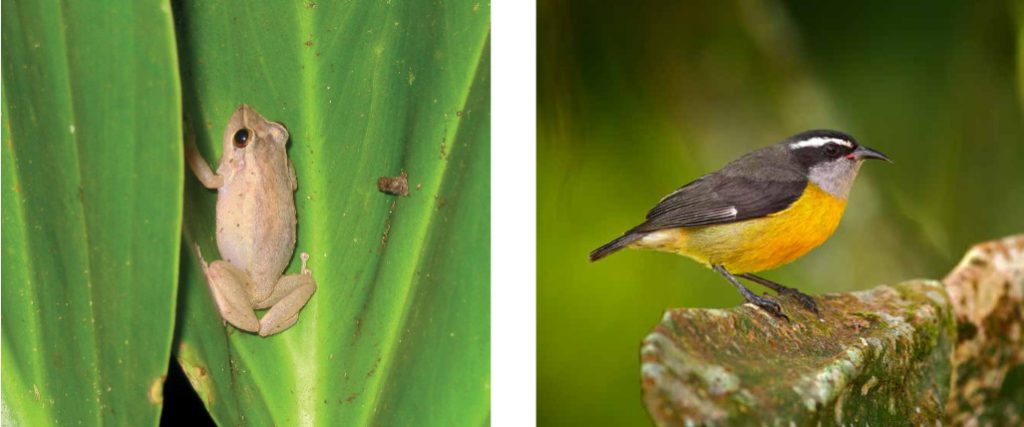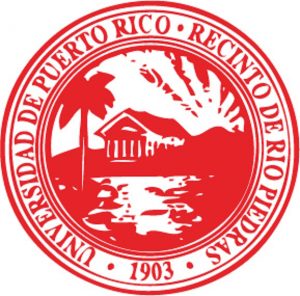Dr Jess Zimmerman – Understanding and Conserving Puerto Rico’s Tropical Ecosystems
Tropical forests and marine ecosystems in the Caribbean are biodiversity hotspots and home to many species found nowhere else on Earth. Increasing environmental stress from a changing climate, such as hurricanes, temperature rises and droughts, threaten to irreparably alter these precious systems. Coupled with ongoing pressures from human activities, some of these areas are especially at risk. Dr Jess Zimmerman and his colleagues at the University of Puerto Rico and throughout the US aim to provide the basis for predicting the future of these ecosystems, through their research at the Luquillo Experimental Forest in north-eastern Puerto Rico.
A Biodiversity Hotspot at Risk
The ecosystems of Puerto Rico are home to a vast array of species. Thanks to the country’s relative isolation, many species that have evolved here are ‘endemic’ – found nowhere else on Earth. The coral reefs, seagrass beds, mangrove forests and coastal plains dominating the island’s coastal regions give way to wet and dry tropical forests further inland.
In addition to their environmental value, these natural systems provide valuable ecosystem services to Puerto Rico residents, such as fishing and farming opportunities, clean freshwater, and some protection from hurricanes that frequently pass through the area. Thanks to their year-round high productivity, marine ecosystems and tropical forests also help to mitigate climate change by acting as ‘carbon sinks’ – capturing more atmospheric carbon than they release.
Contrary to previous suggestions, tropical forests are remarkably resilient to environmental stress. However, resilience is not immunity. Puerto Rico’s precious ecosystems are at risk from a myriad of factors, with many pressures predicted to increase in the coming decades. For example, climate change is increasing the frequency and intensity of droughts and hurricanes. Rising temperatures contribute to coral bleaching, and may permanently alter the composition of tropical forests.
Protecting these wild spaces, while still accommodating the needs of the human population, requires a thorough understanding of the island’s ecology and the long-term impacts of the numerous interacting environmental pressures. Dr Jess Zimmerman from the Department of Environmental Sciences at the University of Puerto Rico and his colleagues in the Luquillo Long-Term Ecological Research (LTER) Program have been exploring how climate change, human activities, hurricanes and other environmental disturbances might be acting together to reduce the health and resilience of tropical ecosystems.
The Luquillo LTER Program, which incorporates the Luquillo Experimental Forest and mountains, and the surrounding urban and coastal areas in north-eastern Puerto Rico, builds on over 100 years of research aimed at informing conservation efforts in the region. Research findings from this forest have fundamentally shaped our understanding of tropical ecosystems, and may help scientists like Dr Zimmerman and his colleagues to more accurately predict potential ecological responses under different climate change scenarios.

Hurricanes: Patterns of Resilience and Vulnerability
The warm air and ocean currents of the tropics generate destructive storms that leave a wake of destruction as they pass over the Caribbean Islands. The variability of hurricanes poses a unique challenge to fully understanding responses of social and ecological systems to environmental disturbance. Hurricanes vary in size, course, wind strength and speed, and cause a range of diverse effects, such as increased wind and rainfall, flooding, and strong currents in coastal areas.
Despite historical assertions that tropical ecosystems are fragile, Puerto Rico’s forests and marine ecosystems exhibit clear adaptations that help them withstand and recover from the storms. Even with extensive damage, Luquillo Experimental Forest researchers have discovered that many tree species resist immediate mortality. In addition, tropical ecosystems exhibit remarkable resilience, with some functions and structures returning to their original state relatively quickly. For example, although green leaf litter deposited onto the forest floor causes a nutrient peak in the weeks following a hurricane, soil nutrient cycling and stream chemistry returned to pre-hurricane levels in as little as five years. However, additional stressors, such as rising average temperatures, may hinder the ability of tropical ecosystems to recover from hurricanes.
Historical records also suggest that hurricanes are becoming more frequent. In the period between 1851 to 1990, Category 1 or higher hurricanes, with wind speeds of over 75 miles per hour, passed over the Luquillo mountains every 50 to 60 years. Adding the hurricanes observed until 2017 reduces the return interval to approximately 42 years. Coupled with their increasing intensity, hurricanes may therefore become a more destructive force in future decades. This could drive a shift towards forests dominated by ‘pioneer species’ – those developing quickly after disturbance events – which suffer higher mortality from hurricane damage than do mature forest species. ‘This change in species composition will have cascading effects on streams, biota and biological processes important to ecosystems, such as their ability to store carbon,’ says Dr Zimmerman.
His group discovered that a gradient of resistance and resilience exists in north-eastern Puerto Rico, with highest levels on the forested ridges decreasing to towards the marine ecosystems of the coast. In the latter, a history of repeated and accumulating ‘anthropogenic’ – or human-caused – disturbance, such as increased sedimentation, overfishing and warming sea waters, has left marine systems especially vulnerable to storms.
For example, corals already stressed by increased temperatures may struggle to thrive after extensive structural damage. Native sea grass colonies destroyed or buried during storms may be more likely to be displaced by invasive species. Additionally, because shallow reefs play a critical role in reducing wave energy by up to 97%, degraded reef systems may become more exposed to the damaging effects of hurricanes.
Shifts in community composition are already being documented in some of Puerto Rico’s marine ecosystems. ‘Chronically declining conditions of coral reef ecosystems due to a combination of cumulative and synergistic anthropogenic and climate change-related impacts are transforming reefs into novel ecosystems, with limited natural ability to recover from disturbances,’ Dr Zimmerman explains.

Effects of Climate Change
Global climate models currently predict substantial changes in the rainfall patterns in the tropics, with strong potential for an increase in frequency and intensity of droughts. In 2015, Puerto Rico experienced the most severe drought since 1994, experiencing only 50% of the annual average rainfall. This extreme event provided the LTER researchers with a unique opportunity to build on their previous rainfall exclusion experiments. The reduction in water availability on the island had visible effects on the forest soils and vegetation, and lead to widespread water rationing for residents.
The team recorded a period of high leaf fall early during the drought, coupled with a 30% reduction in the overall growth of trees. Modelling forest productivity under the scenario of steadily increasing drought and temperature revealed that net forest ecosystem productivity could decrease to zero by as early as 2036. Unless forest composition changes or plants acclimate to the drier conditions, this could result in tropical forests switching from carbon sinks to carbon sources, thereby contributing to a positive feedback loop increasing the rate of climate change. Dr Zimmerman and his colleagues were surprised at this result, and are seeking to refine their modelling efforts to further confirm this prediction.
Drought also increases overall greenhouse gas emissions through other processes. For example, soil moisture exerts strong control on greenhouse gas emissions from tropical soils and soil microbial communities, though Dr Zimmerman notes that more research is still required to fully understand these effects. The increased leaf litter accumulates in freshwater systems, which slows the rate of decomposition and thus increases greenhouse gas emissions. The altered conditions of stream ecosystems further inland may also be at risk of incursion by invasive fish species found in water systems closer to the coast.
The temperature increases expected in the next two decades will push many tropical ecosystems into novel temperature regimes. Even small changes in temperature can have seemingly disproportionate effects on tropical plants, which have evolved within a narrow temperature range and thus may be more sensitive to its effects on photosynthesis and respiration. Alarmingly, evidence suggests that tropical canopy trees may already be reaching their upper temperature limit. Beyond this threshold, trees may exhibit a reduced ability to take up atmospheric carbon.
Animals, and particularly ‘ectotherms’ – which rely on external conditions to maintain their body temperature – may also be sensitive to temperature increases. As with tropical plant species, they have adapted to living in a narrow temperature range, and thus may not have the ability to acclimatise to the new conditions. Some animal species may adjust their ranges to counteract the impacts, for example by migrating further up the mountains; however, many have ranges limited by other factors. The potential loss of species is of particular concern in tropical ecosystems, where a large number of endemic species mean that localised extinction events are often irreversible.
‘In the Luquillo Experimental Forest we anticipate three principal changes wrought by a warming world,’ says Dr Zimmerman. ‘One is the warming itself which may challenge species’ physiological tolerances and alter species demography. The other two potential changes accrue to shifts in the disturbance regime caused by increased warming: an increase in the frequency of intense hurricanes driven by the warmed waters of the North Atlantic, and an increase in the frequency or length of dry periods caused by warming, coupled with a change in the seasonality of rainfall.’

Outlook for Tropical Conservation
While their extensive research has already contributed significantly to our understanding of tropical ecosystem responses, Dr Zimmerman and his colleagues have many more questions they wish to answer. In particular, because human and natural systems are tightly linked, they highlight the importance of also examining how environmental changes and hurricanes affect human populations. Our tropical ecosystems are in grave peril, but by providing the basis for better predictive tools and conservation strategies, research from the Luquillo LTER Program may help us to mitigate some of the damaging consequences of a rapidly changing world.
Reference
https://doi.org/10.33548/SCIENTIA553
Meet the researcher

Dr Jess K. Zimmerman
Department of Environmental Sciences
University of Puerto Rico
San Juan
Puerto Rico
Dr Jess Zimmerman earned his PhD in Ecology from the University of Utah, before continuing onto postdoctoral research at the Smithsonian Environmental Research Center. He currently holds the positions of Lead Principal Investigator of the Luquillo Long-Term Ecological Research Program, and Professor in the Department of Environmental Sciences at the University of Puerto Rico in San Juan. In addition to his research on tropical ecology in Puerto Rico, Dr Zimmerman has also developed educational tools and programs for school students, teachers, and university students. His work has been published in numerous prestigious publications, and findings from his research have contributed to our fundamental understanding of tropical ecosystems.
CONTACT
E: jesskz@ites.upr.edu
W: http://web.ites.upr.edu/faculty-members/jess-zimmerman
KEY COLLABORATORS
Dr Grizelle Gonzalez, US Forest Service
Dr Edwin A. Hernández-Delgado, University of Puerto Rico
Dr Alonso Ramirez, North Carolina State University
Dr Whendee Silver, University of California, Berkeley
Dr Maria Uriarte, Columbia University
Dr Michael R. Willig, University of Connecticut
Dr Tana E Wood, US Forest Service
FUNDING
National Science Foundation
USDA Forest Service
NOAA Coastal Resiliency Program
University of Puerto Rico
National Fish and Wildlife Foundation
FURTHER READING
JK Zimmerman, MR Willig, EA Hernandez-Delgado, Resistance, resilience and vulnerability of social-ecological systems to hurricanes in Puerto Rico, Ecosphere, 2020, in press.

Want to republish our articles?
We encourage all formats of sharing and republishing of our articles. Whether you want to host on your website, publication or blog, we welcome this. Find out more
Creative Commons Licence
(CC BY 4.0)
This work is licensed under a Creative Commons Attribution 4.0 International License. 
What does this mean?
Share: You can copy and redistribute the material in any medium or format
Adapt: You can change, and build upon the material for any purpose, even commercially.
Credit: You must give appropriate credit, provide a link to the license, and indicate if changes were made.
More articles you may like
Grandmothers: Innovation Through Tradition
Grandmother Project – Change through Culture (GMP) is an organisation dedicated to documenting the role of grandmothers and demonstrating the effectiveness of grandmother-inclusive strategies in improving the health and well-being of women, children, and adolescents. GMP’s groundbreaking work challenges conventional wisdom to transform community-based interventions in Africa and beyond, harnessing a powerful but often overlooked resource: the wisdom and influence of grandmothers.
Dr Robert Larkin | Cultivating Change to Improve Soil Health and Increase Potato Yield
Environmental quality and food production are facing the pressing challenges of climate change and global population growth. Dr Robert Larkin from the United States Department of Agriculture-Agricultural Research Service (USDA-ARS) and a team of plant scientists developed and tested a range of crop management systems to help overcome these compounding challenges. Their work is improving soil health and increasing the yield of potato crops, contributing to the future food security of nations.
Professor Giorgio Buttazzo | Artificial Intelligence and a Crossroads for Humanity
Where do we stand with artificial intelligence? Might machines take over our jobs? Can machines become conscious? Might we be harmed by robots? What is the future of humanity? Professor Giorgio Buttazzo of Scuola Superiore Sant’Anna is an expert in artificial intelligence and neural networks. In a recent publication, he provides considered insights into some of the most pressing questions surrounding artificial intelligence and humanity.
Dr Ralf Adam | New Technologies Shaping the Future of Oral Hygiene
Understanding the efficiency of various toothbrush technologies is essential for achieving optimal oral health. Dr Ralf Adam, who leads a dedicated team at Procter & Gamble in Germany, is keen to investigate the complexities of these technologies. His team have provided new insights into the best toothbrush types for plaque removal and the maintenance of gum health. By highlighting the importance of informed oral care decisions and ongoing investigations, this vital research works towards ensuring everyone can achieve a brighter, healthier smile.




